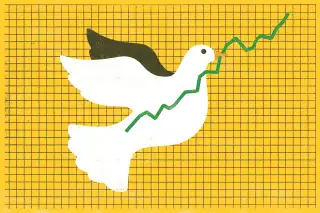Investors Love 'Socially Responsible' Companies. But Sorting the Good from the Bad Is Harder Than It Looks

Sustainable investing seems to be taking over the world, and for good reason: It has an elegant thesis, of betting on companies that are virtuous and avoiding the ones that aren’t.
Easy, right?
Well, real life is never quite as simple as that. Figuring out which companies perform well in terms of ESG – environmental, social and governance factors – is a highly complicated business that is evolving by the day.
After all, a multi-billion-dollar company with dozens of different business lines may behave sustainably in some areas, but not others. Or it may get high overall marks from one ratings agency, but not so much from another.
So does it qualify as an ESG investment, or does it not?
“There are more than 30 different ESG data providers and ratings agencies, each with their own metrics,” says Nathalie Wallace, global head of ESG investment strategy for Boston-based asset managers State Street Global Advisors (SSGA).
“That is a major data challenge, which causes a lot of confusion in the marketplace. For a single company, you can have very different scores.”
That informational crazy-quilt has led fund research giants Morningstar to start lobbying the asset-management industry, to get on the same page with ESG standards, practices and procedures.
As for SSGA, it took matters into its own hands, creating its own “R-Factor” scoring system. It crunches the numbers on various issues like environmental risks, social capital (corporate responsibility efforts), human capital (health and safety of employees), innovation, and leadership and governance.
Real values, real money
Figuring out ESG data isn’t just something for academics to puzzle over: There is real money on the line, and lots of it.
According to a 2018 report by the Forum for Sustainable and Responsible Investment (US SIF), sustainable investing assets in the U.S. have already blown past $12 trillion – or one out of every four invested dollars out there.
That was up 38% from its 2016 report, and its 2020 figures – currently being compiled – will presumably rocket even higher. Even tony firms like BlackRock and Goldman Sachs have been burnishing their ESG credibility, pledging $1 trillion and $750 billion respectively to ramping up sustainability efforts.
So what exactly qualifies as a green investment? That’s where the rubber meets the road – and if it’s any consolation, even the ratings agencies have a hard time figuring this stuff out.
When Massachusetts Institute of Technology researchers looked at ESG evaluations from different ratings companies in a recent working paper, they found an average correlation of only .54 – in other words, there was plenty of disagreement.
“Ratings agencies do not always agree, although that’s not necessarily a bad thing,” says Julian Kölbel, an economist at the University of Zurich and a co-author on the MIT paper, “Aggregate Confusion”. “These are value-driven preferences, and it’s normal that not everyone would agree on them.”
For example, there are hundreds of issues that might get consideration in ESG ratings – anything from water usage, to child labor, to carbon emissions, to human rights. Various ratings agencies might include different issues, measure them differently, and then weight them differently, which of course produces a unique result.
Then there is the elephant in the room: So-called ‘greenwashing’. If you tick the right boxes on enough evaluation forms, even a coal company or a tobacco maker can dress itself up to appear like a green investment.
“Right now companies basically have discretion about which information they want to disclose,” says SSGA’s Wallace. “That can lead to wide discrepancies. If these issues are just left to their own choices and behavior, that’s a big concern.”
A mom-and-pop playbook
Of course it’s almost impossible for individual investors to pore over datasets of this magnitude, so at some point you have trust ESG fund managers and index analysts to have done their due diligence.
Investors who want to do a deeper dive into can look at funds’ sustainability ratings, which analyze the underlying holdings. With Morningstar, those funds with the lowest ESG risk are awarded five ‘globes,’ similar to its classic star-rating system. With analytics firm Refinitiv Lipper, its ESG Scores are awarded on a 100-point scale.
The good news is that the performance of ESG funds seems to be holding up, despite this unfortunate 2020 we are all living through. In the U.S., according to Morningstar, top ESG index funds include Vanguard ESG U.S. Stock ETF, Vanguard FTSE Social Index, and Nuveen ESG Large-Cap ETF, all of which returned around 24% for 2020’s second quarter.
For developed markets outside the U.S., some top ESG index funds for the quarter were Vanguard ESG International Stock ETF, Fidelity International Sustainable Index, and Calvert International Responsible Index, all of which returned roughly 18% in Q2.
With performance numbers like that, you apparently can do well by doing good.
More from Money:
Private Equity May Be Coming to Your 401(k). Investor Advocates Are Crying Foul
Value Stocks Have Been Lagging Growth Stocks for Years. Here's Why You Should Own Them Anyway
What a Second Round of Coronavirus Lockdowns Would Mean for the Stock Market